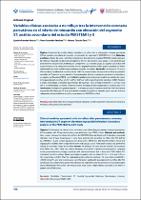Variables clínicas asociadas a no reflujo tras la intervención coronaria percutánea en el infarto de miocardio con elevación del segmento ST: análisis secundario del estudio PERSTEMI I y II

Related Resource(s)
https://apcyccv.org.pe/index.php/apccc/article/view/253Date
2022-12-31Author(s)
Paredes Paucar, Cynthia
Custodio Sánchez, Piero
Chacón Diaz, Manuel
Metadata
Show full item recordAlternate title
Clinical variables associated with no-reflow after percutaneous coronary intervention in ST-segment elevation myocardial infarction: Secondary analysis of PERSTEMI I and II registries
Abstract
Objetivo. Determinar las variables clínicas asociados a no reflujo tras la intervención coronaria percutánea (ICP) en pacientes con infarto de miocardio con elevación del segmento ST (IAMCEST) en el Perú. Materiales y métodos. Estudio de casos y controles retrospectivo, derivado de los registros PERSTEMI (registro peruano de infarto de miocardio con elevación del segmento ST) I y II. Se consideró casos (grupo 1) a los pacientes que presentaron no reflujo tras la ICP, definido porun flujo TIMI<3, y controles (grupo2) a aquellos con un flujoTIMI 3 post intervención. Se compararon variables clínicas y angiográficas entre ambos grupos y se realizó un análisis multivariable buscando variables independientes asociados a no reflujo. Resultados. Se incluyeron 75 casos y 304 controles. La incidencia de no reflujo fue del 19,8%. Se presentó mayor frecuencia de no reflujo en pacientes sometidos a ICP primaria en comparación a farmacoinvasiva, además en pacientes con lesiones uniarteriales y en aquellos con flujo inicial TIMI 0. La mortalidad hospitalaria y la incidencia de insuficiencia cardiaca fue mayor en los pacientes con no reflujo (21,3% vs. 2,9% y 45,3% vs. 16,5%, respectivamente, valor de p < 0,001). Posterior al análisis multivariado se encontró que el tiempo de isquemia > 12 h, un Killip Kimball (KK) > I, un flujo inicial TIMI 0, y la enfermedad uniarterial, fueron las variables asociadas de forma significativa a no reflujo tras la ICP. Conclusiones. El tiempo de isquemia mayor a 12 h, el mayor puntaje KK, la presencia de flujo TIMI 0 en la arteria responsable del infarto pre-ICP y la enfermedad coronaria uniarterial son variables que se asocian de forma independiente la posibilidad de no reflujo en pacientes con IAMCEST en el Perú. Objective. To determine the clinical factors associated to no-reflow after percutaneous coronary intervention (PCI) in patients with ST-segment elevation myocardial infarction (STEMI) in Peru. Methods. Case - control retrospective study, derived from the PERSTEMI (Peruvian Registry of ST-elevation myocardial infarction) I and II. Cases (group 1) were those patients who presented no-reflow after PCI, defined by a TIMI flow < 3, and controls (group 2) were those with a TIMI 3 flow after the intervention. Clinical and angiographic variables were compared between both groups, and a multivariate analysis was performed looking for associated factors to no-reflow. Results. We included 75 cases and 304 controls. The incidence of no-reflow was 19.8%. There was a higher frequency of no-reflow in patients with primary PCI compared to the pharmacoinvasive strategy, in patients with one-vessel disease and in those with TIMI 0 before PCI. In-hospital mortality and heart failure were higher in patients with no-reflow (21.3% vs. 2.9% and 45.3% vs. 16.5, respectively; p<0.001). After multivariate analysis, the ischemic time > 12 hours, Killip Kimball (KK) > I, TIMI 0 before PCI, and one-vessel disease were the factors significantly associated with no-reflow after PCI. Conclusions. The ischemic time greater than 12 hours, the highest KK score, the presence of an occluded culprit artery (TIMI 0) before PCI and an one-vessel disease, were factors independently associated with no-reflow in patients with STEMI in Peru





